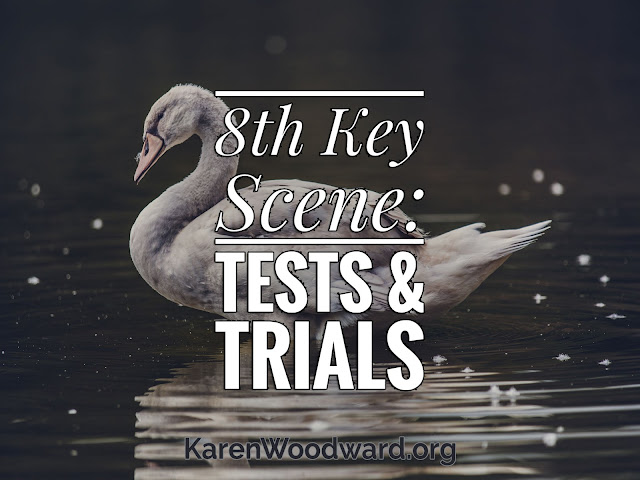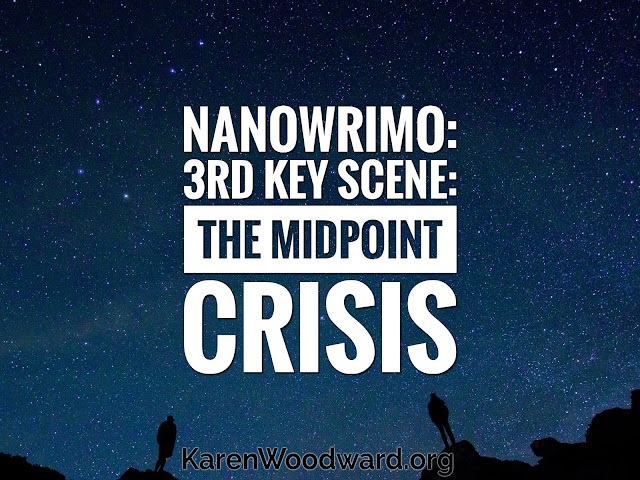As you probably know, I’ve been blogging about story structure more-or-less every day this month. My goal was to isolate around 30 key scenes that the overwhelming majority of well-structured stories contain.
And I still want to do that, but the fact is I’m running out of key scenes! There’s only two left: the Race to the Finish and the Wrap Up. So instead of trying to come up with additional Key Scenes I’m going to delve more deeply into the structure of each one.
Today, though, I’m taking a break. It might not make a great deal of sense to you why I’m blogging about this today. All I can say is that sometimes the muse wants what she wants. Go figure!
Today I want to talk about the structure of a romance story. True, recently I wrote about 6 Scenes Every Love Story Must Have, but this is different. This time I want to delve into the characters in a romance story and how their wants and desires shape events.
I’ve done something like this for mystery stories but not quite this way. I’m not sure what you’ll think of it, so I welcome feedback. This is an experiment. Would you like more posts like this? Would you like NO MORE posts like this? I want to write articles you like reading so please, let me know! :-)
The Structure of a Romance Story
Before we get started ...
- In what follows I use a four act structure.
- In what follows the protagonist is a gal and the antagonist is a guy. When I write, “The girl has a problem,” this means the same thing as, “The protagonist has a problem.”
- Everything that I say in this post has been inspired by these videos. Not JUST those videos, but they do a terrific job of laying the essential structure bare, and in a delightfully tongue-in-cheek way.
Act One
The girl has a terrible problem.
The girl doesn’t always have a terrible problem, but she often does.
Have you read Laurell K. Hamilton’s Anita Blake books? If so, you’re probably wondering why I’m bringing those books up in this context since they’re classified as urban fantasy/horror! I don’t read Hamilton’s books anymore[1], the series morphed into something else, but in the first three books Hamilton developed a beautiful, brilliantly executed, love story between Anita and a vampire named Jean-Claude.[3]
Anita Blake has a problem: she’s a necromancer. Not only do her abilities freak out normal people, they terrify the monsters! And not just zombies. Blake is a licensed vampire hunter who, due to her kill rate, has earned the nickname The Executioner. (So, who do you think she falls in love with? Ding, ding, ding, that’s right! A vampire.)
So, for our example protagonist, in honor of Anita Blake, let’s make her a vampire hunter and (tip of the hat to Sookie Stackhouse) a telepath. I’ll call her Lily Anderson.
What’s Lily’s terrible problem? She’s being driven slowly insane by the steady onslaught of other people’s thoughts. The only solution is to withdraw from society, become a hermit and live in the woods—but Lily feels that’s just another kind of death. Still, she doesn’t have a choice, not if she wants to stay sane.
The boy either refuses to help the girl solve her problem or he lacks the ability to. Furthermore, his very existence makes the girl’s problem worse.
Again, let's follow Hamilton’s lead and make the antagonist a vampire. I’ll call him Damien Morton.
How does Damien’s very existence make Lily’s problem worse? Damien wants Lily to use her powers to help him with a problem he’s having. But using her powers brings Lily to the edge of madness and that’s something she’d like to avoid, thank you very much.
The boy has a unique quality that makes him catnip for most women.
We could explain this by saying that whatever it is that transforms a human into a creature of eternal night refashions the body to make it inhumanly gorgeous.
Or we could say that vampires have certain standards and only turn the spectacularly attractive.
Or we could say that most vampires are no more good looking than most humans, that they only appear attractive because they use their powers to glamor weaker minds into seeing them a certain way. In other words, they use mind control.
I like the last one.
Also, the boy is obscenely rich.
The girl has no interest in this unique quality.
Due to Lily’s mental abilities she is immune from vampiric thought control. She doesn’t see the illusion Dameon projects, she sees him as he really is.
Lily isn’t interested in the boy’s money. She believes that everyone with money, especially if it’s old money, is an insufferable snob. (Not that she’s prejudiced or anything! ;)
The girl finds the boy irresistibly attractive.
Lily sees Damien as he really is and finds him irresistibly attractive.
But Lily’s attraction to Dameon is based on more than the physical. There is something about him, something she can’t quite articulate. She feels as though she knows him even though they’ve only just met.
Lily can’t stop thinking about Dameon. To make matters worse, she has started dreaming about him, odd twisted dreams filled with blood and death.
What is the boy’s problem? What is the thing that makes the girl’s ability very attractive to the boy?
In the Southern Vampire Mysteries, Bill Compton, the first vampire Sookie Stackhouse ever met, was sent to find out everything he could about Sookie and her unique ability. Her other love interest, Eric Northman, routinely wants Sookie to use her telepathic abilities to give him an advantage in business negotiations.
What’s Damien’s problem? Let’s not reinvent the wheel. Damien runs the business interests of a very old, very wealthy, vampire clan. They have a spy in their midst, someone another very old, very wealthy, vampire clan planted. He needs to find out who. His job, his standing, is on the line. He needs Lily to read the minds of his employees and reveal the culprit.
The girl wishes she’d never met the boy because he has made her problem worse.
When Lily uses her ability it takes her to some very dark places.
The boy is not interested in most girls. He intends to stay single forever.
Dameon is a vampire so he can’t date humans—the temptation to suck their blood is too strong—and he despises other vampires. Other sorts of magical critters exist but they aren’t seen much these days. The fey, for example, have fled to another dimension. Some humans have psychic abilities but these abilities are usually so weak that they’re just humans to him. He realizes he is doomed to eternal loneliness and busies himself with work and various charitable foundations.
Even though the boy is committed to the single life, he is attracted to the girl on several levels. This surprises him. He never dreamt he could be attracted to someone like this. The boy’s attraction to the girl makes him feel completely out of control. He doesn’t recognize himself anymore. This makes him angry.
Sure the boy is lonely, but he’s been lonely for a long time. It’s not like he’s never happy. After all, this is the life he chose. It’s the life he made for himself. He’s attached.
Put it this way, his life is a bit like a ratty old bathrobe that has hidden charms for its owner but everyone else looks at with mild disdain.
My point is that the girl makes the boy look at his life in a new way, he feels its defects. She makes him see the old bathrobe through other eyes.
This makes the boy profoundly grumpy. Everything was fine before the girl came into his life. If only she would leave, things could go back to normal.
The girl sees that the boy is angry and doesn’t understand why.
In her mind, everything she has done is reasonable. She can’t understand why he doesn’t like her, why he’s always grumpy with her.
Something bigger than the two of them forces the boy and the girl to work together even though neither of them wants to—or maybe only one of them wants to.
We haven’t yet talked about what brings the boy and the girl together, what forces them to work with each other even though neither of them really wants to.
In Laurell K. Hamilton’s Anita Blake series, Jean-Claude knows about the various supernatural communities in the city and can get people to talk to her. He helps her catch killers and, in so doing, saves lives. But having contact with Jean-Claude is dangerous for Anita. He is seduction incarnate. He is the dark side whispering sweet nothings in her ear.
Even though she knows Jean-Claude is dangerous for her, even though each time she sees him she feels a bit of herself slip away, she has to consult with him in order to solve crimes and save lives.
I wouldn’t say that Jean-Claude behaved like a lunatic, but he is certainly not thrilled about having such a gifted vampire executioner in town. He would like to bring her under his sway, but he knows that is one thing Anita will never allow. And it does drive him a little bit crazy.
How will this work for Damien and Lily? Well, let’s borrow Hamilton’s essential setup only we’ll twist it a bit. Damien wasn’t born a vampire, he was made one by the head of a very old, wealthy, family. That means he’s not really family. Sorta, kinda, almost, but not quite. Nevertheless, Damien has a head for business and under his leadership the family has done well, so they’ve given him free reign with their money. As a result, if anything happens in the city chances are Dameon knows about it or he knows who will know and, if he likes, he can put Lily in touch with them.
As I’ve mentioned, Lily can read thoughts. She has been invaluable to the police. The problem is that her ability is driving her insane. She has tried to quit but the police keep coming to her, begging her to help. “Only you can catch this guy and save another girl from a fate worse than death.” They don’t say, ‘Or madness’ but she feels it hanging in the air between them. She goes back, she always goes back.
There’s only one person she can’t read: Dameon. His mind is like a tall cold glass of water on a hot summer day. The problem is the silence feels good. Too good. It’s addictive. And he knows this. Dameon wants to control her and use her ability for his ends. She’ll let the police pull her back in so she can save lives (as well as the chief’s career) but she won’t let herself be used as a chit in the high stakes games Dameon plays in the underworld.
The boy behaves like a lunatic whenever he is together with the girl. He bosses her around and interferes with her life. For his part, the boy sees many things in the girl he could improve, or would like to see improved. The boy thinks the girl should be grateful for his interference in her life. Because of this the girl begins to hate the boy.
Dameon is pragmatic. If he had Lily’s gifts he could make ever so much more money, but that’s just the beginning. He could have power. Real power. He could break away from the family and begin his own dynasty. It’s not like he would stop Lily from helping the police, if she really wanted to do that. He honestly can’t understand why she refuses to work for him. After all, being around him keeps her sane! But, no. She would rather help the police and go slowly mad instead of helping him make a better life for them both.
For her part, the girl thinks that the boy is a horse’s ass.
Lily thinks that Dameon is an undead calculator. He has no imagination, no heart. And he doesn’t have an unselfish bone in his body.
The bottom line for the girl: He is making her terrible problem worse.
Dameon makes her crazy. Literally.
At the end of every article I post I like to pick a book I love and recommend it to my readers. This serves two purposes. I want to share my favorite books with you, and, if you click the link and buy anything over at Amazon within the next 24 hours, Amazon puts a few cents in my tip jar at no cost to you. So, if you click the link, thank you! If not, that’s okay too. I’m thrilled and honored you’ve visited my blog and read my post. :-)
Today I’d like to recommend a book that I've written! The Structure of a Love Story.
From the blurb: "Love is love, but there tends to be a certain pattern to how it progresses, both in fiction and real life. I go over three different kinds of love stories and pivot to examine six scenes any romance story must have."
That’s it! You’ll notice I’ve only talked about the characters and their dilemmas, I haven’t said anything about what happens in scenes and sequels, I haven’t talked about a Call to Adventure, etc. I’m saving that for later. What I’ve done here is intended to be something like a Zero Draft; writer’s jazz. We’re just playing, making word pictures.
Tomorrow—unless you tell me to stop!—I’ll follow this post up with Act Two.
How’s NaNoWriMo coming along? I’m a little behind at 19,454 words. I had hoped to be at about 26,000 by this point.
Talk to you tomorrow, good writing! :-)
Notes
1. I loved the first three books in Laurell K. Hamilton’s Anita Blake series and unreservedly recommend them. I stopped reading the series around 2010 because (and this is just my own opinion) Anita Blake was no longer the same character I had been introduced to in Guilty Pleasures. Neither was Jean-Claude, and a great deal of the appeal of that series was the changing, tumultuous, visceral, relationship between those two characters.
3. Regardless of their primary genre many stories have a love story as the B-Story.









